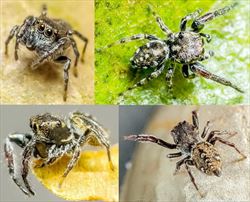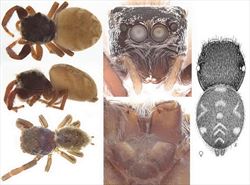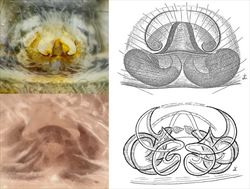
Examples of live Bianor
Illustrator (and ©) R. Whyte

Aspects of the general morphology of female (TL, ML) and male (BL) specimens of Bianor
Illustrators (and ©) B.J. Richardson (CSIRO), M. Żabka (diag.) (QMB)

Palp morphology of Bianor
Illustrators (and ©) B.J. Richardson (CSIRO). M. Żabka (diag.) (QMB)

Epigyne morphology of Bianor
Illustrators (and ©) R. Whyte (TL), B.J. Richardson (BL) & M. Żabka (diag.) (QMB)
Bianor Peckham & Peckham, 1886
Taxonomy
Bianor is a cosmopolitan genus with two Australian species: Bianor maculatus and a very poorly-known (doubtful) second species: Bianor concolor. The genus is related to Harmochirus, which also has a species whose range extends to Australia (Maddison 2015). Further information on the genus and described species can be found in Richardson and Żabka (2017) and Whyte and Anderson (2017).
Description
In Australia, Bianor spp. are small spiders with a body length around 3 mm. The head, viewed from above, is rounded, widest behind the posterior lateral eyes. The posterior lateral eyes overlap the edges of the cephalothorax. The abdomen is round to ovate and can be much wider than the cephalothorax. The head is mostly dark brown or black, the upper abdomen of the female with various light-coloured to white splotches, chevrons and blobs, the male having golden blotches. The chelicerae each have a single retromarginal tooth (unident) with two teeth on the promargin. The first pair of legs is only slightly longer and stronger than the remaining legs. The male has enlarged femurs on the first pair of legs (shiny underneath) and sparse to thick white facial hair.
The male’s palp is compact, with the embolus arising as a wide duct at about 8 o’clock on the face of the tegulum, proceeding up and clockwise around the simple, rounded tegulum, eventually moving to the outside of the tegulum and ending in a very slender, finely tapered point distally. The simple, sharp retro-lateral tibial apophysis is short.
The female’s epigyne has the appearance of a raised, central hood in the anterior part, with atria either side. The copulatory openings are at the rear of the atria beneath well sclerotised guides. Large, convoluted, spermathecal ducts and chambers can be seen laterally well past the atria.
Biology
Bianor has been found from desert to woodland living on the ground, on grass, on tree trunks, on other surfaces and on foliage. It is also found around houses and is common on railings and fences. Bianor is common in cotton crops across Australia.
Distribution
Bianor has been collected across mainland Australia but not in Tasmania. The genus is also found in Afrotropical, Neotropical, Palaearctic, Oriental, and Pacific Regions.
References
Berry, J.W., Beatty, J.A. & Prószyński, J. 1996. Salticidae of the Pacific Islands. I. Distribution of twelve genera, with descriptions of eighteen new species. Journal of Arachnology24, 214-253.
Davies, V.T. & Żabka, M. 1989. Illustrated keys to the genera of jumping spiders (Araneae: Salticidae) in Australia. Memoirs of the Queensland Museum 27, 189-266.
Logunov, D.V. 2000. A redefinition of the genera Bianor Peckham & Peckham, 1885 and Harmochirus Simon, 1885, with the establishment of a new genus Sibianor gen. n. (Aranei: Salticidae). Arthropoda Selecta 9, 221-286.
Maddison, W.P. 2015. A phylogenetic classification of jumping spiders (Araneae: Salticidae). Journal of Arachnology 43, 231-292.
Richardson, B.J. & Żabka, M. 2017. Salticidae. Arachnida: Araneomorphae. Canberra, Australian Faunal Directory. Australian Biological Resources Study, at https://biodiversity.org.au/afd/taxa/SALTICIDAE.
Whyte, R. and Anderson, G. 2017. A Field Guide to Spiders of Australia. CSIRO Publishing: Clayton.
Żabka, M. 1985. Systematic and zoogeographic study on the family Salticidae (Araneae) from Viet-Nam. Annales Zoologici, Warszawa 39, 197-485.
* The information sheet should be interpreted in the context of the associated diagrams and photographs. Diagrams explaining anatomical terms can be found in the ‘Salticidae’ pictures at the beginning of the list of genera.